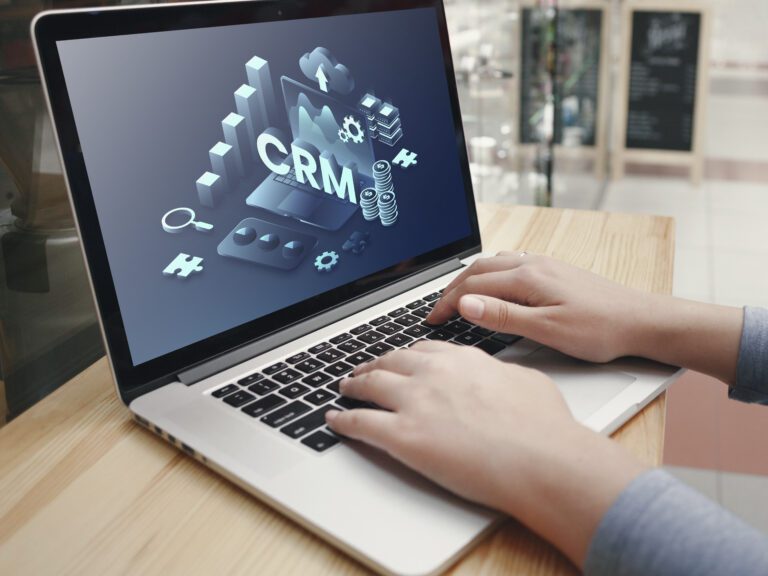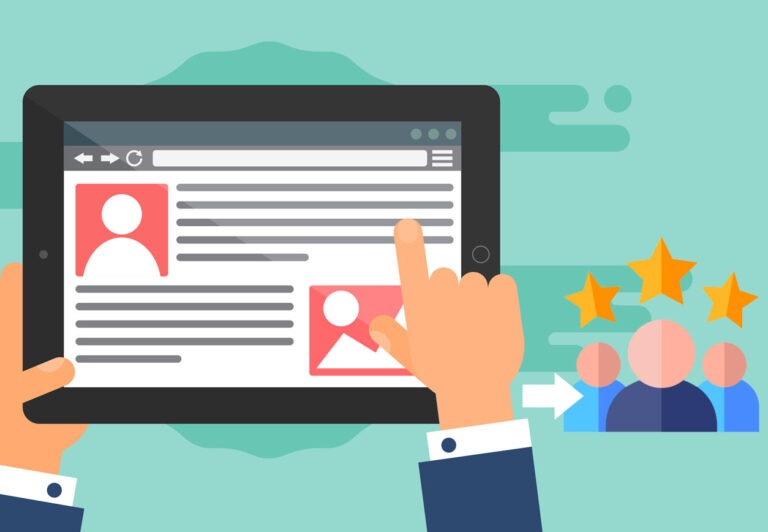11 Best B2B Lead Generation Strategies of 2025

I hope you enjoy this blog post. If you want Hello Bar to grow your leads, click here.
Author:
Ryan Bettencourt
Published
July 2, 2024
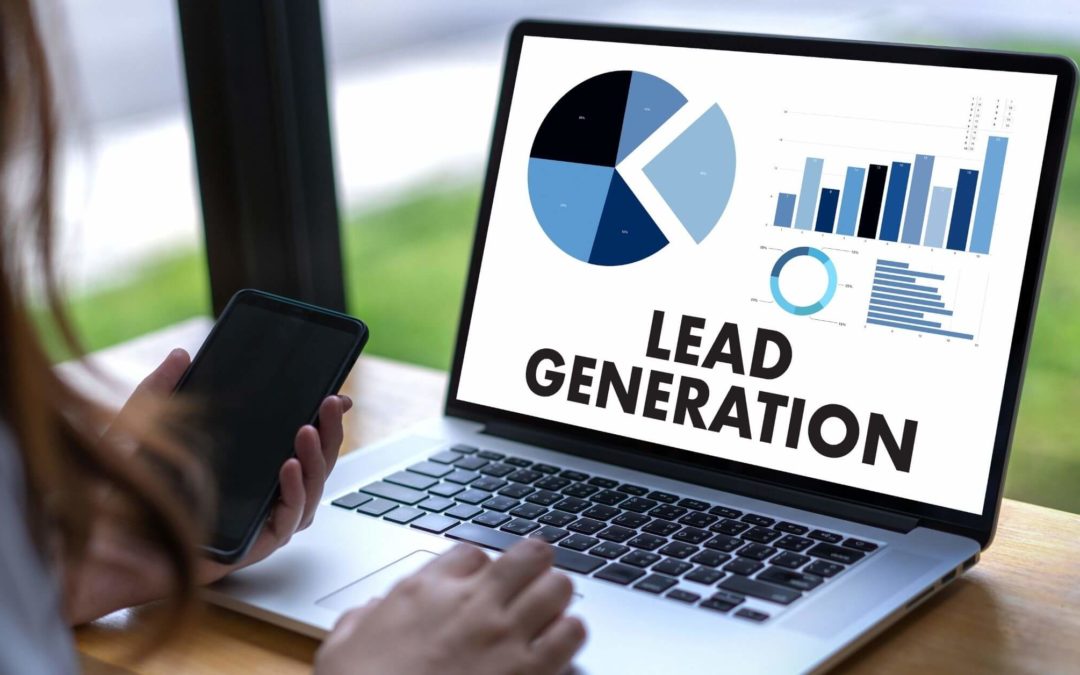
Lead generation is one of the critical aspects of any B2B marketing strategy. Without leads, you won’t acquire any new customers or make sales. Simply put, it will be impossible to reach your growth goals without lead generation. It’s no wonder that the global lead generation software market is projected to reach $11,301 million by 2030.
But the reality is that generating leads isn’t an easy task. In fact, 65% of marketers say that generating leads and traffic is what they struggle with the most.
You need the right strategies in place to effectively generate and nurture B2B leads. Going into a lead generation campaign haphazardly will only increase your customer acquisition costs.
To help you get started, I have written this article on the best B2B lead generation strategies you can try out today.
Let’s get started.
What Is B2B Lead Generation?
B2B lead generation is the process of identifying and attracting potential business clients interested in your company’s products or services. The B2B lead generation process includes various stages, starting from identifying the target customer.
Once identified, prospects are engaged through social media campaigns, webinars, and email marketing. Other channels include content marketing and networking events.
B2B lead generation helps nurture prospects through the sales funnel toward conversion. Some ways B2B lead generation differs from B2C lead generation include:
- Target Audience: B2B targets businesses, while B2C aims at individual consumers.
- Decision-Making: B2B involves longer, more complex decisions; B2C often seeks quicker purchases.
- Relationship Focus: B2B emphasizes long-term partnerships; B2C typically aims for immediate sales.
- Marketing Approach: B2B relies on logic and ROI; B2C often leverages emotional appeals.
- Sales Cycle: B2B usually involves a longer sales cycle with multiple stakeholders. Meanwhile, B2C tends to have a shorter cycle with direct consumer engagement.
Types of B2B Leads
Lead generation is essential for business growth as it attracts potential clients who are interested in your offerings.
In line with this, you must also understand the different types of B2B leads so you can tailor your strategies to effectively engage and convert potential leads.
Here’s a table showing a detailed view of the different types of B2B leads.
|
Type of Lead |
Description |
Characteristics |
|
Marketing Qualified Leads (MQL) |
Leads that have shown interest in your marketing efforts and are more likely to become customers |
Engaged with content, filled out a form, downloaded an ebook, attended a webinar |
|
Sales Qualified Leads (SQL) |
Leads that have a high chance of turning into a customer because they’re interested in your offering and have the money to purchase |
Is a repeat customer, downloaded a white paper or filled out a form, engaged in sales conversations, ready for direct contact by the sales team |
|
Product Qualified Leads (PQL) |
Leads that have already experienced the value proposition of your offering via a free trial |
Started a free trial, used freemium features extensively, provided feedback, indicated interest in premium features |
|
Service Qualified Leads |
Leads that have indicated a desire or need for your service and are ready to talk to a service representative |
Requested service details, scheduled a consultation, demonstrated a clear service need |
|
Cold Leads |
Leads that have shown no interest in your offering |
Unresponsive to outreach, no previous engagement with your brand |
|
Warm Leads |
Leads that have shown some interest but aren’t ready to purchase yet |
Opened emails, visited your website multiple times, commented or liked your posts on social media, showed mild interest |
|
Hot Leads |
Leads that are very interested and are ready to make a purchase soon |
Engaged with your brand several times, requested a demo, actively inquired about pricing, showing high purchase intent |
B2B Lead Generation Process
Understanding the B2B lead generation process is essential for businesses looking to attract and convert potential clients. It involves strategically attracting, engaging, and qualifying businesses that could benefit from your product or service.
The process is the foundation for building a strong sales pipeline. Here’s a breakdown of the key steps involved:
Identify Your Target Audience
First, clearly define your ideal customer profile (ICP). This is a detailed profile outlining the characteristics of the companies you want to reach. Consider factors like:
- Industry: Which industries are experiencing problems your solution addresses?
- Company Size: Are you targeting small businesses or large enterprises?
- Decision-Makers: Who within the target companies has the authority to purchase?
- Needs and Pain Points: What challenges are your ideal customers facing?
By outlining your ICP, you can tailor your lead generation efforts to attract the most relevant businesses.
While at it, consider dividing your market into specific segments. This allows you to more effectively tailor your marketing efforts.
Craft Valuable, Compelling Content
Once you know your target audience, the next step is building awareness about your brand and offerings.
Create high-quality, relevant content that addresses your target audience’s needs, including:
- Blog posts and articles
- whitepapers and ebooks
- Case studies and success stories
- Webinars and video tutorials
Consistently providing valuable content positions you as a thought leader. Therefore, be sure to optimize your website for search engines for organic discovery. Also, promote your content on platforms like LinkedIn and X, and consider paid advertising.
Set Up Lead Capture Mechanisms
Once you’ve attracted potential clients, the next step is to capture their information. Here’s how you can deploy effective lead capture tools across your digital properties:
- Create compelling landing pages
- Implement lead capture forms like those offered by HelloBar
- Use exit-intent popups to capture leaving visitors
- Offer gated content in exchange for contact information
Nurture Leads and Build Relationships
Not all leads are ready to buy immediately. You want to score and qualify prospects as you guide them through the sales funnel. Crucial processes in this stage include:
- Developing targeted email drip campaigns
- Establishing clear handoff processes between marketing and sales teams
- Continuously monitoring and refining your lead generation efforts
Lead Generation Strategies to Implement in 2025
Going into 2025, businesses should adapt their lead generation strategies to keep up with dynamic market trends. Here are some strategies that can help businesses gain more high-quality leads in today’s competitive landscape.
1. Create gated content
Gated content is any content that your website visitors can only access by filling out a form and giving their information. This information can be the visitor’s name, email address, contact information, etc.
Gated content is an effective way to generate new leads. But how does gated content work?
When viewers land on your website, they are shown a pop-up or CTA button that offers them access to a valuable piece of content in exchange for their information.
For increased conversions, your pop-up might direct the viewer to a landing page where they are giving more information on the content offer. The copy of the landing page should be valuable enough to entice the user to give their information.
Note that gated content should not be hidden behind a paywall. The visitors need to submit only their information to get access to the content.
There are pros and cons to using gated content. Depending on your marketing goals, ungated content might be more suitable. Ungated content like blog posts and infographics are more suited for increasing traffic and improving brand visibility. Gated content is more suitable for lead generation.
Let’s see some of the pros and cons of gated content:
Pros of gated content
- Generate more leads for your business
- Increase your sales
- Provides insight into your customer at each stage of the buyer’s journey
- Allows for email list segregation
Cons of gated content
- Decrease in traffic and page views
- No brand visibility
- There are no SEO benefits
- If your landing pages and sign-up forms are not properly optimized, most people will not offer their information.
Simply put, gated content is best if you are trying to generate leads that you can nurture into paying customers. Ungated content is best if you want to increase your traffic and visibility.
2. Offer something free
One of the best B2B lead generation strategies is offering freebies to prospects. People love free stuff. When used effectively, offering a freebie can help you generate leads and reach new potential customers.
The mistake that most businesses make is offering freebies with no value to the prospect. A customer won’t bother filling out a form if they aren’t receiving any value in return.
Your freebie will act as a lead magnet to attract potential customers. Here are some rules you should follow when using freebies as a lead magnet:
It must solve a problem
Any freebie you offer must help the visitor solve a specific problem.
A good example is this offer by The Sales Evangelist.
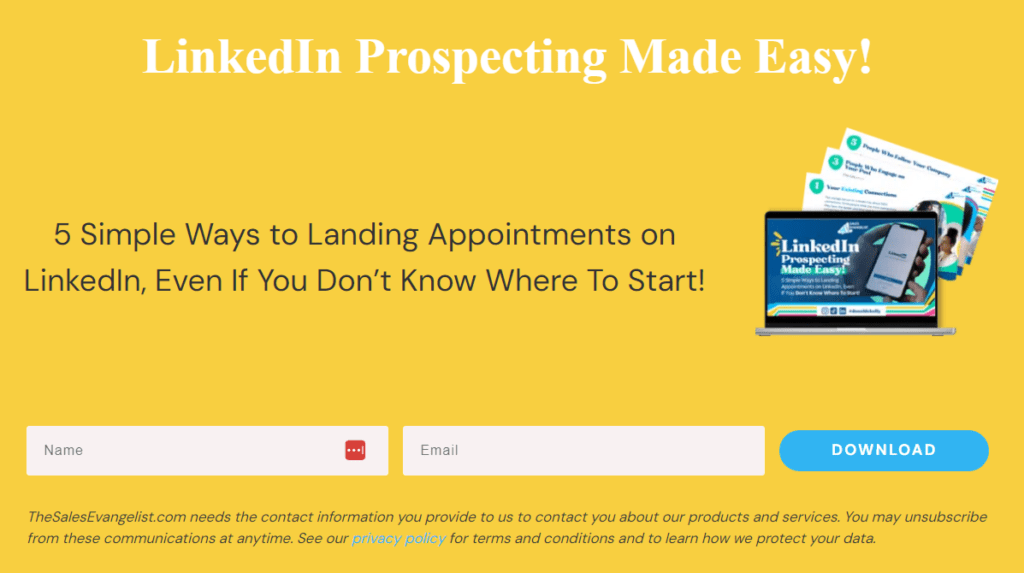
This is geared towards businesses who want to land more appointments on LinkedIn. By simply providing their name and email address, potential clients can gain access to the resource and solve this problem.
The best part is that the copy is straightforward. Having a simple layout like this increases the likelihood of conversion.
It must be available instantly
Make sure the freebie can be accessed immediately when the prospect fills out the form. You don’t want to keep them waiting for hours or days. Prospects have a short attention span. If you waste time, you might end up losing the lead.
The freebie should be relevant to your core message
Your goal shouldn’t be to generate a ton of leads. Your goal should be generating leads that can become potential customers. So if you are offering freebies as a lead magnet, it should be relevant to your core business offering. For example, if you sell email marketing software, your lead magnet can be an ebook that teaches prospects how they can increase their email open rates. If you sell IT asset management software, on the other hand, it could be about tips on how to secure expensive IT assets.
3. Host an event
The advantage of this strategy is that you can gain leads both online and offline. You can host an online or offline event and generate leads via event registration.
Aside from generating leads, hosting an event will help increase brand awareness and also establish a face-to-face relationship with potential customers.
Webinars are a great way to host events. As a 2023 ClickMeeting survey found, marketers were responsible for as much as 24% of online events. Their events focused on lead generation, customer onboarding, product presentations, and demos. Marketers were second only to power users (26%).
Consider this free webinar by Semrush which it uses to gain new leads. The brand collects information such as the attendee’s name, organization type, business email, and more.
Here’s what their opt-in form looks like:
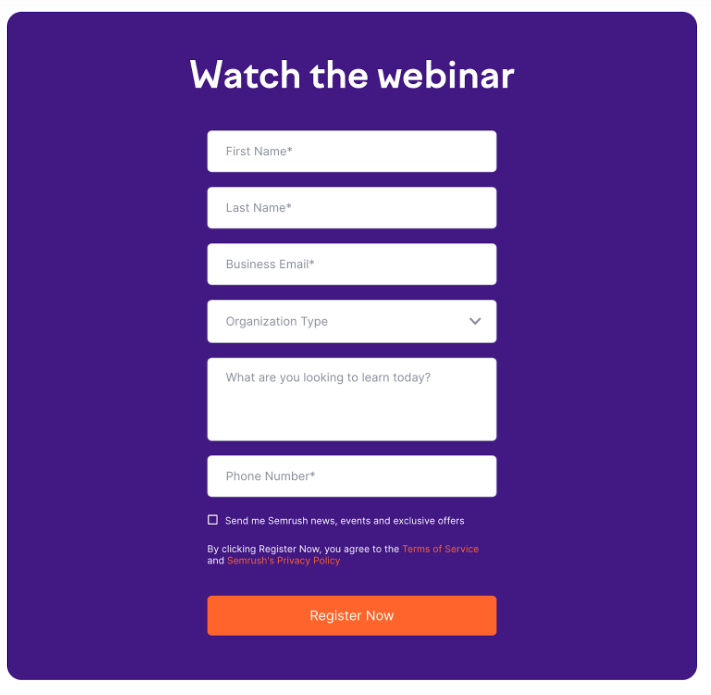
Image via Semrush
4. Create a high-converting landing page
When generating leads via your website, your landing page is very important. Directing a ton of traffic to a poorly optimized landing page is similar to putting a leaky bucket under a running tap. It’s simply a waste of time and resources.
You must create a landing page that is optimized for conversions.
Here are some simple tips you can use to optimize your landing page for lead generation.
Simplify the landing page: The best landing pages are simple. A cluttered landing page will only distract the visitor. Your value proposition and call to action must be clear and easy to identify.
A good example is this landing page from Milanote.
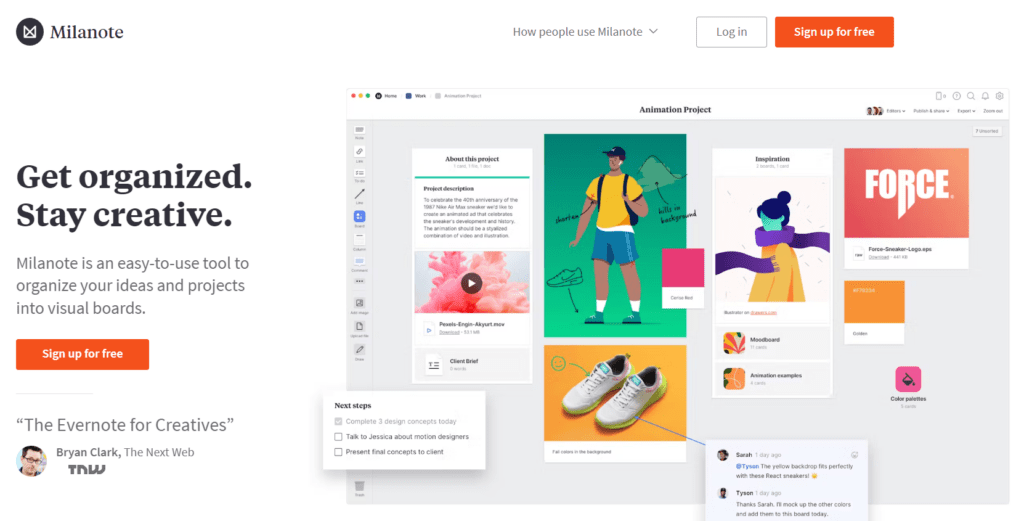
Image via Milanote
This page effectively combines promotional material with images of how their app works.
Use contrasting colors: You want your CTA button to pop. Use a contrasting color from the background of the landing page on your CTA button to make it very visible.
This is a great example from Aura Dating Academy.
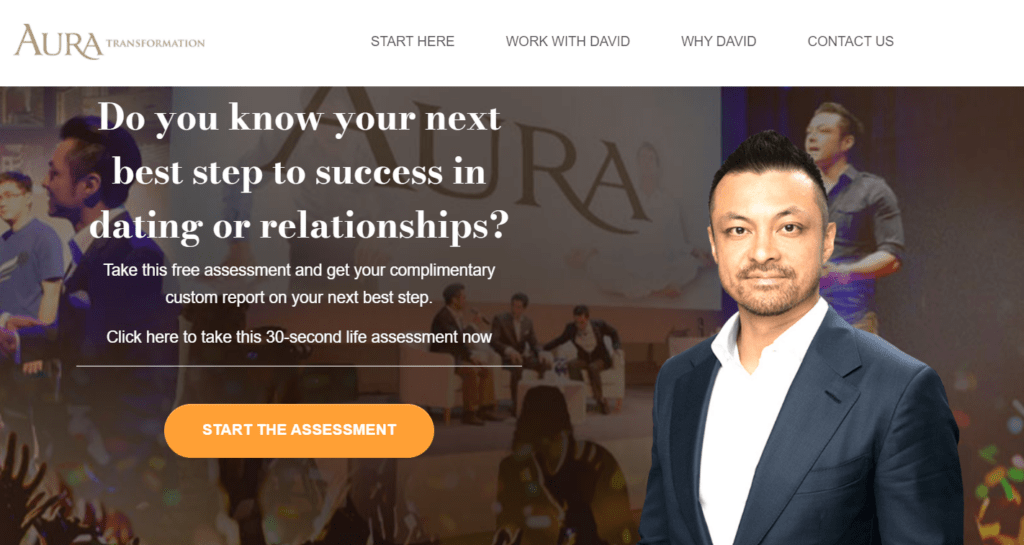
The orange color of the CTA button contrasts with the dark background making it very visible. The visitor can’t miss it.
Use a descriptive CTA button: Instead of using the normal CTA buttons like “Join Now” or “Sign Up”, get creative. The examples above from Aura Dating Academy and VideoFruit are examples of how you should write a CTA button copy.
5. Target top-of-funnel keywords
SEO and lead generation work hand in hand. To direct prospects to your landing page, you need to first create content that attracts them to your website.
To generate high-quality leads, you must create content that targets top-of-funnel keywords.
To do this, get started with keyword research.
Research the keywords that your target audience is searching for and create awesome content around them. Use an SEO tool to perform keyword research. You should also analyze the keywords your competitors are targeting.
After curating the list of keywords, create valuable content that is optimized for those terms. You can also target the keywords using pay-per-click advertisements.
The more visible your website is on search engines, the more traffic you get. Increased traffic will translate into more leads.
6. Take advantage of referral campaigns
Referral campaigns are one of the easiest ways to generate B2B leads. Big brands like Uber and Airbnb use referral marketing to increase brand visibility and bring traffic to their websites.
For example, Uber awards its existing users with “Free Rides” when they refer their service to family and friends.
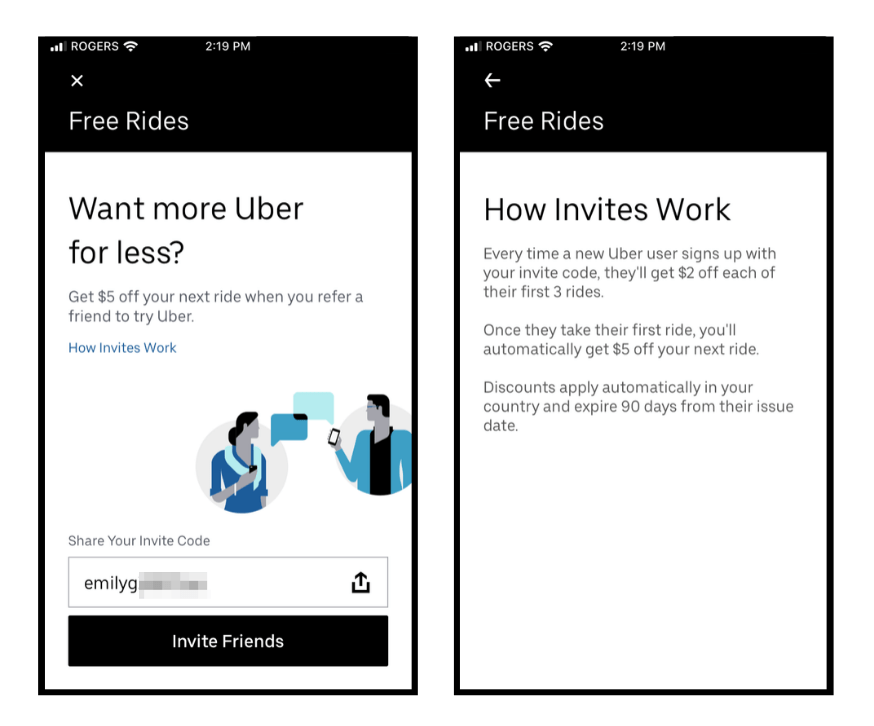
Image via Voucherify
Referral marketing works because of the rewards the customer receives for referring your product or service. If you ask your customers to refer your business without offering any reward, they might not take any action. You have to offer them an incentive to encourage them to start referring.
Your rewards can be a gift card, discount code, a percentage of the sales, and more. The key is to choose rewards that will be valuable to your customers.
Why should you bother with referral marketing?
A staggering 92% of consumers rely on referrals and recommendations from their friends and family. No wonder, 82% of marketers rate referral marketing as the most effective lead-generation strategy.
7. Upsell on your popular blog content
This is a simple but effective way to easily generate new leads. If you have an article that is doing very well and generating a ton of traffic, you shouldn’t just let it go to waste.
You can offer content upgrades on your popular blog articles to attract leads. Content upgrades can be a PDF of your blog posts, a helpful checklist, an industry report, or a valuable case study. The key is to offer a content upgrade that the reader will find valuable.
A good example of a content upgrade is this cheat sheet from Smart Blogger.
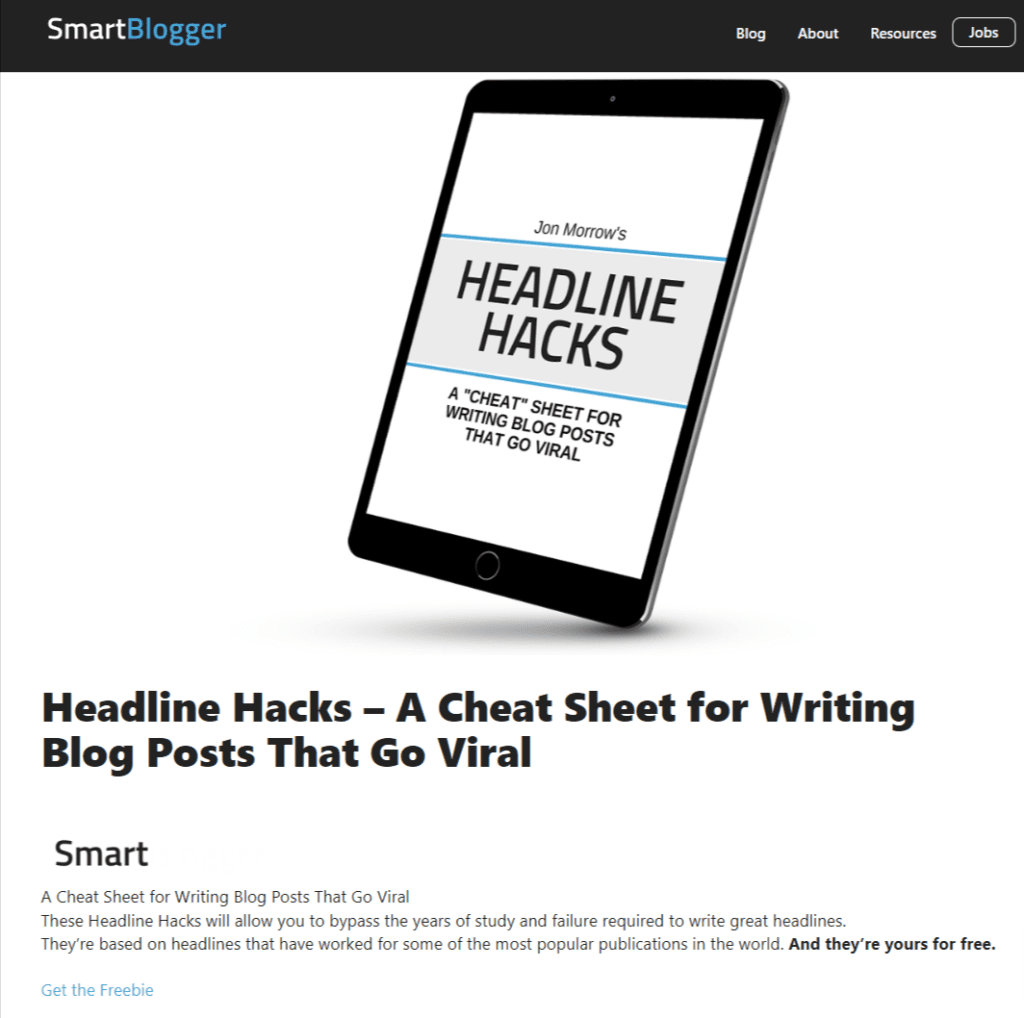
Potential customers can access this cheat sheet by providing their email address. To boost lead generation, the page emphasizes that this is a free resource with valuable benefits.
8. Generate leads through social media
Social media is the perfect channel to generate new leads. Since the majority of your target audience is on social media, it will make sense to reach out to them there.
The first step is to choose the right channel. You’ll increase your conversions and ROI when you concentrate on the platforms where your audience is most active. The social media platform you choose will depend on your industry and product/service you offer.
Before starting a social media marketing campaign, ensure that your target audience fits the demographic of the platform. For example, LinkedIn is a great lead generation channel for B2B marketers. B2B Marketers say that LinkedIn generates two times more leads than other social media and marketing channels.
Some tips for using social media for lead generation:
- Optimize your profile: Before running a social media campaign, it is important that you optimize your profile. Add your contact information so that prospects can easily reach you – whether by phone, email, or the social media in-app messenger.
- Create call-to-action buttons: Depending on your goals, add call-to-action buttons to your profile and posts. For example, if you want to collect email subscribers, you can add a Sign-Up button to your profile page.
- Create awesome content: Prospects won’t visit your profile or click on your CTA button if they are not receiving value from your updates. If you want to increase the engagement you receive on your posts, you need to create awesome content.
- Use social ads: You can use social media advertisements to boost your lead generation efforts.
- Run contests or sweepstakes: Running social media contests is a great way to generate leads. You can ask the user for their information to participate in the contest.
9. Use HelloBar to capture B2B leads
98% of website visitors will leave without taking any specific action. You can change that with HelloBar. As an effective growth marketing tool, HelloBar allows you to display pop-ups, full-page takeovers, and static bars to help you convert your website visitors into customers.
HelloBar comes with a simple editor that allows you to create custom call-to-action. It also comes with ready-to-use templates and a great A/B testing feature. The tool helps you understand how your audience reacts to your website. It also integrates with other tools like MailChimp, Campaign Monitor, Segment, etc.
If you’re looking for an efficient way to generate leads via your website, collect more email addresses, and direct visitors to your conversion funnel, then check out HelloBar.
10. Optimize the messaging of your website’s microcopy
It’s the little things that make a difference.
The messaging of your website’s microcopy can play a huge role in helping direct visitors to your conversion funnel. Think of microcopy as a little voice leading users in their journey through your site. It’s important that you optimize them for conversions.
A good example of the effect of a website’s microcopy on lead generation is Veeam.
After changing the phrase “Request a quote” to “Request Pricing”, Veeam increased the clicks to their pricing page by 161.66%.
Control:
Variation 1:
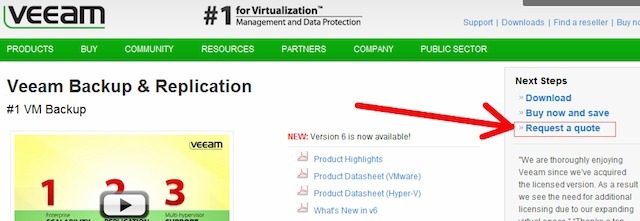
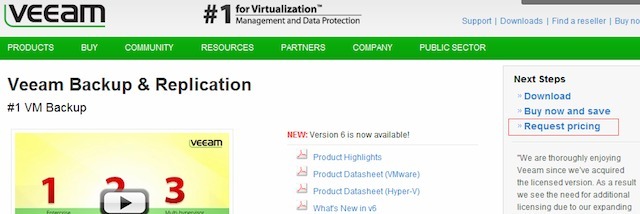
Image from Veeram
You can start by adjusting the microcopy on your pricing, product, pop-up forms, and landing pages.
The best part of microcopy optimization is that you don’t have to make huge changes to your website to start seeing conversions. Just changing a CTA button from “Sign up” to “Sign up for your free demo” is enough to increase your lead conversions.
11. Leverage chatbots
The use of chatbots has been growing, not just in customer service but also when it comes to digital marketing and lead generation. These AI-powered assistants can interact with visitors in real-time. They can provide immediate responses and personalized experiences to move prospects along their journey on your website.
How do chatbots work for lead generation?
When a visitor lands on your site, a chatbot can pop up to greet them, answer initial questions, and direct them to relevant resources. This interaction can capture valuable information about the visitor’s needs and contact details. They’re then qualified as leads for your sales team.
Here are some ways to effectively use chatbots for lead generation:
- Automate initial interactions: Use chatbots to welcome visitors and gather basic information about their needs and interests.
- Offer personalized recommendations: Based on the visitor’s responses, chatbots can suggest relevant content, products, or services, increasing the chances of conversion.
- Schedule appointments: Chatbots can handle appointment scheduling, allowing potential leads to schedule a meeting with your sales team without the need for back-and-forth emails.
- Provide 24/7 support: Unlike human agents, chatbots can operate around the clock, ensuring that you never miss an opportunity to engage with a potential lead.
B2B Lead Generation Tools to Maximize Your Sales
In today’s competitive market, using the right B2B lead generation tools can significantly enhance your efforts and drive sales growth.
These tools streamline various aspects of the lead generation process, from identifying potential customers to building strong relationships and closing deals.
By using these advanced tools and the data-driven insights they provide, businesses can optimize their strategies and achieve better results.
Below, we explore some of the most effective B2B lead generation tools that can help you gain high-quality leads and maximize your sales potential.
Leadfeeder
This B2B lead generation tool shows you which companies visit your website based on their IP address. They then match these companies with their contact database to provide you with essential B2B intent data to help you drive business growth.
Leadfeeder integrates into your CRM, so you can access leads’ visit data directly in HubSpot, Pipedrive, Salesforce, or other supported CRM.
Install Leadfeeder’s tracking script so you can monitor visits from companies and refresh the leads every hour. It also tracks website activity to help you identify which leads are ready to purchase.
There’s no setup fee. It also provides a free forever plan that provides information for up to 100 companies, with data being stored for seven days. The paid plan starts at $165/month.
Hubspot Sales Hub
Designed for productivity, HubSpot Sales Hub changes the outdated “do more, sell more” approach. It focuses on enhancing quality over quantity, equipping your company’s sales teams with the tools they need to boost productivity and create deeper client relationships.
Its popular features include lead management and prospecting, customizable email templates, sales automation, call tracking, and more. With these features, HubSpot Sales Hub empowers teams to turn more leads into deals efficiently.
It offers a free forever plan, requiring no credit card and providing access to up to 5 users. The Starter plan begins at $20/month/seat.
Dealfront Target
Dealfront Target is a powerful B2B lead generation tool that identifies website visitors and provides detailed insights about their behavior. It integrates with CRM and marketing automation platforms, enabling sales teams to engage with potential leads more effectively and personalize outreach efforts based on real-time data.
The tool provides a free forever plan, showing data from the previous seven days for a maximum of 100 identified companies. The platform provides custom pricing for its clients.
Reply.io
Reply.io is an all-in-one sales engagement platform designed to automate and optimize communication with prospects. It supports multi-channel outreach via email, phone, and social media to enable personalized and scalable lead-generation campaigns.
Although it doesn’t have a free forever plan, it does provide a 14-day risk-free trial. Paid plans start at $59/month.
Bombora
Bombora is a leading provider of B2B intent data, helping businesses identify prospects showing active interest in their products or services.
By analyzing online behaviors across a vast network of sources, Bombora provides actionable insights that enable more targeted and timely outreach, enhancing the effectiveness of lead generation and marketing efforts.
You can request a demo to test the tool.
FAQ
Q1. How can account-based marketing (ABM) improve B2B lead generation?
Account-based marketing (ABM) improves B2B lead generation by targeting specific high-value accounts with personalized campaigns, increasing engagement and conversion rates, building stronger relationships, and ensuring marketing and sales alignment for more effective and efficient lead nurturing.
Q2. How can chatbots enhance B2B lead generation efforts?
Chatbots enhance B2B lead generation by engaging visitors in real time, answering queries instantly, and qualifying leads through automated conversations. This helps increase conversion rates and ensures potential leads are promptly directed to sales teams for follow-up.
Q3. Why is SEO important for B2B lead generation?
SEO enhances your brand’s online visibility and drives organic traffic to your website and social media platforms. It attracts high-quality leads by ensuring your business appears prominently in search engine results when potential clients seek relevant solutions.
Q4. How can email marketing automation improve B2B lead generation?
Automating email marketing can personalize outreach, ensure timely follow-ups, nurture leads throughout the sales funnel, and optimize engagement through data-driven insights. This ultimately increases the efficiency of your lead generation efforts.
Q5. Why is lead scoring important for B2B lead generation?
Lead scoring helps you prioritize leads based on their potential to convert. This allows your sales teams to focus on the most promising prospects to increase conversion rates.
Conclusion
Lead generation takes time and effort, but it’s worth it. By following the top B2B lead generation strategies we’ve outlined above, you can start generating high-quality B2B leads in no time.
In this article, we’ve also discussed the differences between B2B and B2C lead generation, types of B2B leads, outbound vs inbound marketing, and some top B2B lead generation tools to maximize revenue.
Which of these strategies will you add to your lead-generation efforts? Leave your thoughts in the comment.



